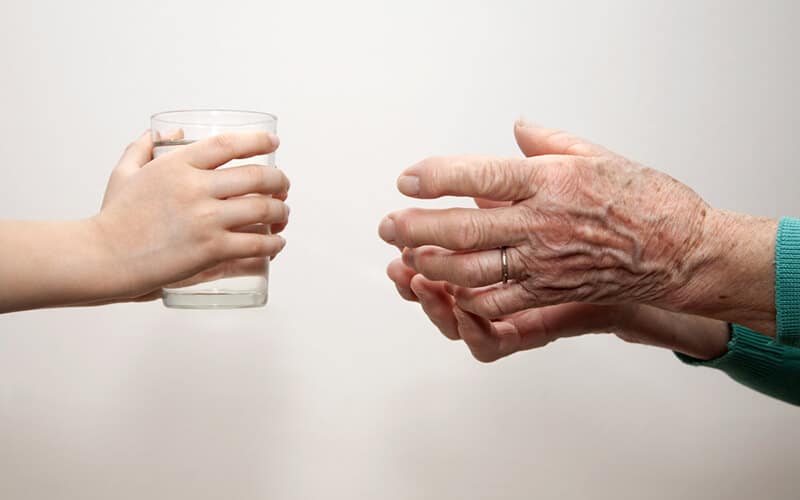Is There A Treatment For Parkinson’s Disease?

After Alzheimer’s, Parkinson’s is the second-most common neurodegenerative disease. In the United States alone, there are 1 million people who live with this disease and more than 60,000 are diagnosed each year.
Parkinson’s affects the nervous system and any part of the body controlled by nerves, causing progressively worsening tremors, balance, posture, and muscle stiffness as the disease develops. While there is no cure at the present, there are a few Parkinson’s disease treatment options that can significantly improve symptoms, including medication, surgery, therapy, and lifestyle remedies. Getting an accurate and immediate diagnosis is crucial. Prompt treatment for Parkinson’s in its early stages can effectively slow its progression.
In this article, we will provide an overview of the disease, focusing on treatment for Parkinson’s, and end with a discussion on the alternatives to treating Parkinson’s disease. If you believe you or a loved one has Parkinson’s disease, don’t hesitate to speak with a medical professional. Ruling out other underlying conditions and finding the right treatment plan are important first steps to ensuring the best possible quality of life.
Contents

What Is Parkinson’s Disease?
Parkinson’s is a progressive neurodegenerative disease. It causes cellular loss in a specific part of the brain responsible for modulating motor movement called the substantia nigra. The disease typically develops slowly over the course of many years, making it increasingly difficult to perform essential day-to-day activities due to unintentional or uncontrollable movements as time goes on.
Parkinson’s disease has a late onset age at around 50 to 60 years old. Only around 4 percent of people with Parkinson’s are diagnosed before the age of 50. The disease is also more common in men as opposed to women, although the exact reason requires further research.
In general, it is believed that Parkinson’s disease is caused by a combination of genetic and environmental factors, with some forms of the disease being linked to gene mutations. The specific cause of Parkinson’s is unknown and more studies are being conducted to determine the factors that increase a person’s risk of developing the disease.
The initial Parkinson’s symptoms are subtle and difficult to notice. Some early signs may include:
- Slight tremor in one finger or hand
- Loss of smell
- Poor posture or slight staggering gait
- Quiet or low voice
- Less facial expression
If you experience any combination of the above symptoms, contact a medical professional to get an accurate diagnosis as soon as possible.
As Parkinson’s disease progresses, the symptoms will become more explicit and bothersome. Symptoms usually start on one side of the body and continue to worsen. The disease can manifest and develop differently for everyone, but here are some symptoms to look out for in addition to the early signs:
- Tremors in hands, head, jaw, or legs
- Lack of balance and coordination
- Muscle stiffness and muscle contractions
- Decreased ability to perform automatic movements, such as blinking
- Slowed movement
- Slurred speech
- Difficulty writing or small handwriting
- Depression
- Insomnia
- Constipation
Parkinson’s is also often confused with other conditions, namely essential tremor. Essential tremor and Parkinson’s disease are both adult-onset tremor disorders characterized by disruptive, uncontrollable shaking. However, essential tremor is likely caused by a miscommunication between the cerebellum and other parts of the brain rather than a gradual loss of dopamine-producing brain cells.
In addition, essential tremor tends to manifest at an even later age, with 4.67 percent of adults over the age of 65 being affected by this disorder in the United States. Unlike Parkinson’s, the main symptom of essential tremor is shaking and difficulty controlling one’s hands. The head nodding typical of essential tremor is also usually not seen in people with Parkinson’s.
Like essential tremor, while non-life-threatening, Parkinson’s can severely impact one’s ability to live an independent and fulfilling life. Luckily, with treatment for Parkinson’s, many of its symptoms can be adequately managed.

Treatment Options For Parkinson’s Disease
Medication
Medication is a first-line treatment for Parkinson’s disease, especially for people with less severe symptoms. Medications used to manage Parkinson’s typically increase or act as a substitute for dopamine, helping to manage issues with mobility. While medication can be extremely effective at first, it should be noted that many patients notice a slight drop in efficacy as they build up a tolerance.
Parkinson’s disease treatment options include medications such as:
- Levodopa: Levodopa is the most commonly prescribed medication for Parkinson’s and considered the most effective. Absorbed through the blood from the small intestine, it is then converted into dopamine in the brain. It is prescribed in conjunction with carbidopa, another dopamine promoter, to lessen side effects such as nausea and prevent the premature conversion of dopamine outside the brain. Levodopa is available in oral, inhaled, and infusion forms.
- Dopamine Agonists: Rather than changing into dopamine, dopamine agonists mimic the effects of dopamine, tricking the brain. Common side effects of dopamine agonists include sleepiness, involuntary movements, hallucinations, low blood pressure, and compulsive behaviors.
- Amantadine: Amantadine is usually prescribed in the early stages of Parkinson’s disease for people who experience mild symptoms. Initially created as a medication to treat influenza, amantadine is known to reduce tremors and manage the involuntary movements that come with taking dopamine medications.
- Adenosine A2A Antagonists: Also known by the brand name Istradefylline, adenosine ASA antagonists target the basal ganglia to allow more dopamine to be released.
- COMT Inhibitors: COMT inhibitors tend to be prescribed alongside levodopa in order to prolong its effects. They function by blocking an enzyme that can break down dopamine.
- Anticholinergic Drugs: Anticholinergics are used to control the tremors caused by Parkinson’s. Older patients, especially those over the age of 70, have a harder time tolerating their cognitive slowing side effects.
- MAO-B Inhibitors: MAO-B inhibitors prevent the enzyme MAO B from metabolizing dopamine. These medications can be used on their own or with other medications to reduce motor fluctuations.
Surgery
For patients who experience extensive symptoms or for those who no longer benefit from medication, surgical procedures can be an effective treatment for Parkinson’s disease. Currently, there are two main surgery options available for people with Parkinson’s. They are:
- Deep brain stimulation (DBS): While DBS cannot stop the progression of Parkinson’s disease, it can treat involuntary movements, reduce tremors, improve muscle rigidity, and even stabilize one’s response to dopamine medication such as levodopa. During the surgery, electrodes are inserted into the brain to interrupt the electrical signals responsible for certain symptoms. Then, in a second procedure, a pacemaker-like impulse generator battery is implanted near the abdomen or collarbones to stimulate the areas of the brain that control movement.
- Duopa: Duopa therapy administers carbidopa-levodopa directly to the small intestine in a gel form. This surgery improves the absorption of levodopa and prevents the effects of the medication from fluctuating. Patients who respond well to levodopa may be good candidates for this procedure.
Physical & Occupational Therapies
Physical and occupational therapies tackle treating Parkinson’s disease with a holistic approach. Physical therapy helps people with Parkinson’s stay active. Through balance training, resistance workouts, and a regular exercise schedule, physical therapists can work with you to address any fears or issues you are facing in terms of mobility and movement.
Occupational therapists, on the other hand, help you identify ways you can help yourself live the best life possible. Occupational therapy engenders positivity, allowing you to set goals for yourself and recognize how to utilize both your strengths and limitations.
Lifestyle Remedies
Of course, other than medication, surgery, and therapy, there are also changes you can make in your own life to make Parkinson’s more bearable. Lifestyle remedies are just as important as other Parkinson’s disease treatment options.
For example, a nutritious and well-balanced diet is conducive to feeling happy and energized. Other than making sure you eat vegetables, fruits, and proteins that contain the necessary vitamins and minerals you need, certain diets like the Mediterranean diet are believed to combat the constipation and digestion issues experienced by people with Parkinson’s. Getting an adequate amount of exercise on a regular basis is also a great way to manage your symptoms and improve your quality of life.

Are There Alternatives To Parkinson’s Disease Treatments?
Unfortunately, there is no cure for Parkinson’s disease. However, medication, surgery, therapy, and lifestyle remedies are proven treatments that can control and even improve Parkinson’s symptoms. In addition to these options, you can speak with a medical professional to see if there are any alternative therapies such as acupuncture, massages, and biofeedback that can aid your management of Parkinson’s.
Keep in mind that treatment works differently for everyone. Getting an early and accurate diagnosis is the best thing that you can do for yourself, especially because Parkinson’s is so often mistaken for other conditions such as essential tremor.
If you are experiencing essential tremor, Cala TAPS therapy can help. Cala therapy is delivered on an FDA-cleared, non-invasive device you can wear on your wrist to relieve hand tremors. Working in 40-minute sessions to disrupt the tremor network in the brain, it is calibrated to each patient’s unique brain signal pattern. 64 percent of patients reported persistent relief for an average of 94 minutes after using Cala therapy. The device can be used on its own or with essential tremor medications. Speak with your medical provider today to see if Cala TAPS Therapy is right for you.